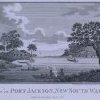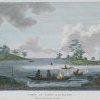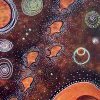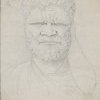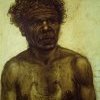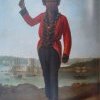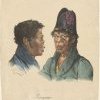1790s
1790
A stockade is built at Woodford Bay, Lane Cove, by soldiers to protect convict grass-cutters and timber-getters from Aboriginal attack. Pemulwuy, a feared Koori warrior and leader, is said to have led attacks on it.
Bennelong escapes from Governor Phillip’s house.
Willermarin, a Koori man visiting from the north, spears Governor Phillip at Manly Cove. Phillip has taken up the invitation of Bennelong to attend a whale feast. Phillip is the victim of an attack and is speared in the shoulder, staggers back to his longboat while his soldiers disperse the Aboriginal people. Phillip does not order retribution and Bennelong is later welcomed back into Phillip’s confidence.
A small band of Bennelong’s clan stays at the governor’s expense and is rationed from his stores. It appears that an informal truce has begun.
Phillip notes “the weather now being very dry, the natives were employed in burning the grass on the north shore opposite Sydney, in order to catch rats and other animals, whilst the woman were employed in fishing: this is their constant practice in dry weather.”
Pemulwuy, a Koori from near Parramatta, fights the invasion by the English through attacks upon the settlement. His group commits many raids killing or wounding 17 people. Pemulwuy spears Governor Phillip’s game keeper John McIntire who dies from his wounds. Governor Phillip orders a punitive party to bring back six Aboriginal people dead or alive, and even issues bags for the heads. Phillip is under much pressure from the famous English naturalist Joseph Banks to obtain Aboriginal skulls promised to other scientists.
1791
On an expedition to the Hawkesbury River with Colbee, Marine Captain Watkin Tench notes that the dialect of the sea coast is also spoken at Parramatta.
David Collins identifies the north shore clan as Cameragal, “by far the most numerous. … most robust and muscular”. They officiate in ceremonies for many clans, in which the boy’s front upper tooth is knocked out”. Collins notes that the Cameragal had the best fishing spots around the harbour, North Head, Middle Head and the Spit. (Collins 1975)
Tench observes language differences: “Although our natives (in Sydney) and the strangers (Hawkesbury River) conversed on a par and understood each other perfectly, yet they spoke different dialects of the same language”. (Tench 1996)
1792
1793
1794
Pemulwuy leads his men on a raid at Parramatta and is wounded. Collins notes ‘the natives have become troublesome … forcibly taking provisions and clothing from convicts”. (Collins 1971 vol 1, p. 297)
Collins recorded “some settlers had been attacked by a party of armed natives and stripped of their provisions. Reports of this nature have been frequently brought in and it was noticed, that as the corn ripened, they constantly drew together” (round the paddocks to steal the corn). (Collins 1971 vol 1, pp. 297, 328)
1795
1796
Koori people are “beginning to annoy the settlers” on the Hawkesbury, John Lacy operating a passenger boat from Sydney to the Hawkesbury is killed. Governor Hunter asks settlers to “mutually afford assistance to each other by assembling when ever any numerous body of the natives are known to be lurking about”. (HRNSW vol 3, p. 26)
“The settlers of the northern farms have frequently lost clothing and provisions as a result of the Aborigines. The settlers armed themselves and in the fight, five Aborigines were killed.” (Collins 1971 vol 2, p. 27). “The Aboriginal people were no longer the object of pity or cruel amusement … the murder of Aboriginal men was justified on the grounds that the Aborigines were treacherous, evil minded, blood thirsty set of men”. (Clark 1962, p. 145 quoted in Morris 1978). By the end of the first Hawkesbury conflict it is unofficially not always regarded as murder to carry out indiscriminate killing of Aboriginal men, women or children by settlers or by government punitive expeditions. Many colonists believe that they should not be prosecuted for protecting their crops.
1797
James Webb, a ship builder on the Hawkesbury River, sails a new boat with his crew to Sydney with a load of corn. They are drifting peacefully down the river when they come upon a party of Koories who were friendly and unarmed in their canoes. The Koories board the boat, and begin inspecting the rigging and masts. James Webb watches suspiciously and calls one of his crewmen to position himself near the muskets and shoot. Webb and his mate fire point blank at the Aboriginal men. Four are shot and the rest jump into their canoes and paddle away out of range of the guns. The Koorie bodies are pushed overboard. (Swancott 1967, p. 25)
1798
Collins describes the situation on the Hawkesbury as open war. William Caley, a botanist writes:
This sort of war lasted about 12 months at which time an order from England arrived respecting their behalf, and then the scene was reversed for instead of shooting or killing them (Aborigines) the orders were given for no one to molest them unless they were committing some depredation. The cause of the war began about some sheep which stock-keepers said the natives had speared… they revenged themselves by killing one of the stock keepers. (Morris 1978)
1799
Bungaree is recruited from Broken Bay by Mathew Flinders to accompany his voyage of exploration in the Porpoise. He is probably 18 years old. Flinders writes of him, “His achievements are many, his character excellent and his conduct on the voyage assisted Flinders to survive the numerous meetings with many Aboriginal clans”. (Smith 1992)
Bungaree is recruited by Lieutenant Grant in the ship Lady Nelson. He helps guide the exploration of the Hunter River.
Two Aboriginal boys are killed near Windsor by five Hawkesbury settlers. A court martial finds them guilty but refers sentencing to the Secretary of State for the Colonies and the men are released on bail. The court is told that the boys were tortured then murdered as revenge for the death of Simon Freebody. Many months later, the men are set free
Bungaree is described by David Collins, the first Judge Advocate of the colony, as “a native of the Northside of Broken Bay”. His people have travelled through the Ku-ring-gai language area from Lake Macquarie to Kirribili.
On 8 July, Bungaree joins Matthew Flinders on a journey to explore around the north (Brisbane). The explorer describes him as “a good disposition” and having “manly conduct”. Bungaree acts as an interpreter and go-between with the Aboriginal people that the ship encounters. He makes friends with Flinders’ cat, Trim.
The explorers fire their muskets at Aboriginal people on Bribie Island.






